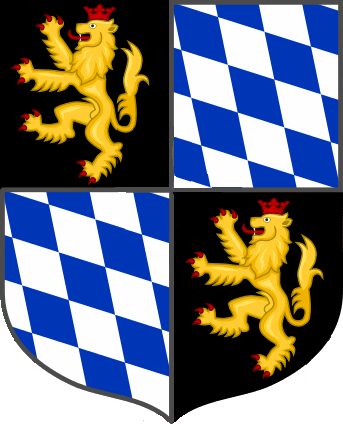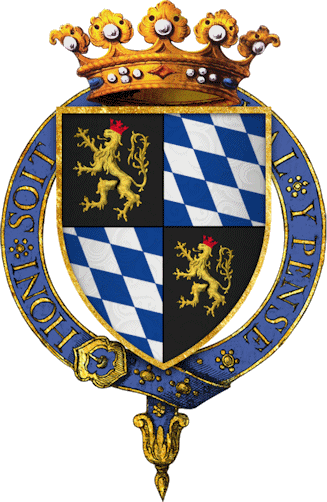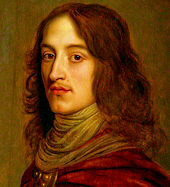Few historical figures of the seventeen century are more colorful than Prince Rupert.
For the sake of clarity, we'll tell his multi-faceted story by presenting his family and the
historical circumstances first, followed by what's mostly a chonological
account of the events in his life.
Prince Rupert of the Rhine (1619-1682)
was the fourth of the thirteen children born to
Frederick V of the Palatinate (1596-1632)
and his wife Elizabeth Stuart (1596-1662)
the second child and eldest daughter of King James I
of England (James IV of Scotland).
Rupert was born in Prague during the brief period (1619-1620) when his parents held
the Crown of Bohemia, at the onset of the
Thirty Years' War (1618-1648).
Frederick V had inherited the title of Count Palatine at the age of 14 upon his
father's death (1610)
along with the prestigious dignity of
Elector Palatine
(German: Prinz der Pfalz).
He owned a palace in Heidelberg,
where he added a new wing (the English wing)
and commissioned the Hortus Palatinus for his new wife.
He was a staunch Calvinist,
which had made him a suitable prospect for the vivacious young Elizabeth
(then known as the Pearl of Britain) who was only seven days older than him.
Both were just 17 when they got married.
Although their marriage was clearly a political one, the two youngsters were very much in love
with each other. They had a new child almost every year.
For the wedding of his daughter, King James threw atypical lavish celebrations.
On that occasion, William
Shakespeare (1564-1616) released
The Tempest,
reportedly the last play he wrote alone.
The Winter Kingdom :
Frederick was head of the Protestant Union
formed by his late father.
He was persuaded by his powerful Dutch uncle Maurice
of Orange-Nassau (1567-1625) to accept the crown of Bohemia from the group of insurgents responsible for the
Defenestration
of Prague (23 May 1618) the event which precipitated thirty years of religious wars throughout Europe.
The majority of Bohemia was Protestant.
In 1617, the Bohemian Crown had gone to
Ferdinand of Styria, who was a proponent of the
Catholic Counter-Reformation.
In 1619, Ferdinand was elected Holy Roman Emperor as
Ferdinand II.
The Protestant insurgents removed him (illegally) from the Bohemian throne by crowning
Frederick in his place on 4 November 1619.
The Czech remember the ensuing short reign as the Winter Kingdom
and Rupert's father is derisively called the Winter King.
That crowning escalated the conflict. Besides the Prince of Orange himself, all of Frederick's
potential allies were now reluctant to help the cause of a 23-year old illegitimate king
against the Catholic forces marching against him.
He had to flee with his family and a few
courtiers,
hours after his defeat at the
Battle of White Mountain,
which took place at Weissen Berg (now part of the city of Prague)
on 8 November 1620.
Crying baby Rupert was thrown by a courtier
into the luggage compartment of the very last departing carriage...
Exile in Holland :
To crush the Protestant Union and its young leader,
Tilly,
the victor at White Mountain, went on to capture Heidelberg itself in 1622.
Duke Maximilian then ordered part of the famous Heidelberg library sent to the Vatican
(where it stayed for two centuries under the name of Palatine Library).
The rest served as straw for Tilly's stables.
Under Imperial ban since 1621,
Frederick V lost for good the Palatinate and his electoral dignity,
which were formally transferred to Maximilian
of Bavaria (1573-1651) at the
Diet of Regensburg (25 February 1623).
The Peace Treaty of Westphalia (1648)
would later return the Rhenish Palatinate and a newly-created electoral vote to Rupert's older brother
Charles Louis (1617-1680)
sixteen years after the death of their father.
However, the Upper Palatinate
remained a province of Bavaria.
After their Bohemian episode, the growing Palatine family took refuge at the court of the aforementioned
Maurice of Orange (1567-1625)
who was the uncle of Rupert's father.
Since 1585, Maurice (Morits) had progressively become
Stadtholder (effective head of state)
of all provinces of the new Dutch Republic,
except Friesland.
He had become Prince of Orange on 20 February 1618.
Previously, he was known as Maurice of
Nassau
and his court was in Breda.
Holland was in the midst of the Dutch War of Independence
against Habsburg Spain.
This was first known as the Dutch Revolt
(French: Révolte des gueux) and it would go down in history as the
Eighty Years' War
(1568-1648). Preliminaries had begun as early as 1566.
The upraising against the Spaniards (and their regent in Bruxelles)
had great popular support at first. However, it soon crystallized along
geographical and religious lines and became a conflict between Catholics in the South,
who turned around to support the regime, and insurgents in the North.
Not all insurgents were Protestants but most of them were.
The Catholics of the south affirmed their support for the Habsburgs with the
Union of Arras (6 January 1579)
in reaction to which the
Union of Utrecht came about
(23 January 1579) ultimately morphing into the
Dutch Republic,
the confederacy
whose formation (1588) escalated the War.
The Habsburgs didn't even acknowledged the Dutch Republic until what's now known as
the Twelve Years' Truce
(signed in Antwerp on 9 April 1609).
Hostilities resumed in the wake of the Thirty Years' War
and the two conflicts would be settled together by the
Treaty of Westphalia (1648).
The Palatine family became pensioners of the Dutch.
They lived in a house which had little to do with the splendor of their former Heidelberg palace.
The children coped by regularly enacting a return to Heidelberg by carriage, using chairs from the living-room as props.
All in the Family :
Rupert's younger sister Sophia (1630-1714)
would go down in History as the mother of King
George I of Great Britain (1660-1727).
Born in Hanover and ratified
Prince-elector of Hanover in 1708,
George I ascended the
British throne in 1714
(at age 54) as the closest living Protestant relative of
the late Queen Anne (1665-1714).
The Act of Settlement of 1701
had removed Catholics from the line of succession, thereby promoting his mother Sophia
to the position of heir presumptive.
(She would have been Queen if she had lived two more months!)
The current British monarch descends directly from George I.
Prince Rupert himself never married but he had two illegitimate children by two different women:
Ironically, if Rupert had married, one of his hypothetical legitimate descendants
(possibly Ruperta) would have
qualifted for the Throne in 1714, ahead of his younger sister's son (who then duly became King George I).
Alternately, if Rupert had outlived Queen Anne, he would have ascended the Throne himself, at age 95!
Legacy :
Prince Rupert was born Prince of Bohemia and
Prince of England, Scotland and Ireland.
In 1644, he was also made Duke of Cumberland and Earl of Holderness
by the grace of his uncle
Charles I (1600-1649)
King of England, Scotland, and Ireland from 1625 until his execution at the end of the
English Civil War (under Oliver Cromwell).
Rupert was never Count Palatine of the Rhine (the title went to his older brother).
In German, he's known as
Ruprecht von der Pfalz.
The highest British honors were bestowed upon Prince Rupert: He was
a Knight of the Order of the Garter (KG, 1642)
and a Privy Counsellor (PC, 1662).
His signature is the third one on the
first royal page
of the Royal Society's Charter Book,
underneath that of the first patron, King Charles II.
Rupert became an honorary member
in 1664 and made a point to share with the Royal Society
his many inventions, mostly related to military technology.
He also played a crucial rôle in perfecting
mezzotint printmaking,
whose invention is usually credited to the contemporary German amateur engraver
Ludwig von Siegen (1609-1680)
who inaugurated the
"light to dark"
technique in 1642 and produced a mezzotint portrait of Ruppert's own mother
Elizabeth in 1643.
Prince Rupert invented the mezzotint rocker and was
the first to use the "dark to light" approach;
the two-step method preferred by many modern artists.
- First, the shiny copper plate is uniformly treated with a large rocker,
creating many tiny ink-retaining pits
one row at a time.
(After this step, the plate would just produce a very dark print.)
- Next,
the image is burnished by the artist with varying degrees of vigor.
(In a burnished area, the pits are eliminated and the plate retains little or no ink.)
Besides that lasting contribution and the puzzling properties of Prince Rupert's drops
(the prelude to tempered glass,
discussed below)
Prince Rupert is also remembered, among scientists and recreational mathematicians at least,
for his wager
that a cube could pass through a hole carved into a slightly smaller one.
The story was recounted in 1693 by John
Wallis (1616-1703) who put forth the reasoning which settled the issue in favor of Rupert.
Prince Rupert is buried in Westminster Abbey.
Chronological Biography of Prince Rupert :
Rupert (Ruprecht, in German) was born on 17 December 1619 in Prague,
during the short Winter Kingdom period when his young parents
ruled Bohemia. He was thus born Prince of Bohemia.
The growing family was soon exiled to the court of his father's uncle,
the Prince of Orange (1567-1625).
Rupert's mother
Elizabeth Stuart (1596-1662)
was the second child and eldest daughter of King James, the reigning monarch of England,
where Rupert would end up spending some of his youth and the last part of his life (after the Restoration, in 1660).
In 1629, the oldest brother of Rupert drowned at sea in tragic circumstances.
His once over-confident father lost the will to live and died from a trivial illness in 1632.
As refugees in the court of an embattled prince, young Rupert and his brothers naturally
took an overriding interest in the military.
In 1633, at age 14, Rupert accompanied the new (1625)
Prince of Orange (Frederick
Henry, 1584-1647) on the siege of Rheinberg.
In 1635, he joined the lifeguard of the Prince in the invasion of
Brabant.
In 1636, he accompanied his older brother
Charles Louis
to the royal court of their uncle Charles I in England.
By then, the 17-year old Rupert was already a handsome tall young man
(he grew to be 6'4'') who made quite an impression with the ladies of the court.
The young prince then fought again alongside the Prince of Orange.
He was present at the fifth siege of Breda (1637).
With his older brother, he joined an army of Scottish mercenaries led by
James King
(1589-1652, future Lord Eythin) in an invasion of Westphalia.
They were defeated by Field Marshal
Hatzfeldt (1593-1658)
at the
battle of Vlotho (17 October 1638)
where Rupert was captured (and held prisoner for 3 years
in the castle of Linz, Austria).
During his captivity, Rupert learned the art of engraving,
studied military textbooks and had a love affair with the daughter of the governor of Linz.
He refused to convert to Catholicism but was eventually released in October 1641
through the diplomatic efforts of Charles I, on the sole condition that he would never again
bear arms against the Holy Roman Emperor.
Battle-hardened Rupert viewed the outbreak of the
English Civil War (1642-1651)
as an opportunity to resume his military career.
He arrived in England in August 1642 with his younger brother Maurice and an
staff of English and Scottish veterans from the European wars, determined to fight
for his cousin King Charles. He became the archetypal
Royalist Cavalier fighting the
Parliamentarian Roundheads.
At this time, Rupert was just 23. The Order of the Garter was conferred upon him
and he was appointed commander of the
Royalist Cavalry.
In November 1644, Rupert was made Captain-General of the Royalist army,
as the Prince of Wales was only nominally commander-in-chief.
He had great successes at first and acquired an aura of invincibility
which intimidated his opponents on the battlefield.
In those days, superstition was everything.
Then the winds turned.
The decisive engagement was arguably the
Battle of Naseby
(14 June 1645) where the Royalist forces suffered 6000
casualties (out of 7400) against the
New Model Army.
The King had chosen to give battle rather than follow Rupert's advice, which was
to keep marching North to join forces with the Scottish Royalists under the command of the
Marquess of Montrose
(the Great Montrose, 1612-1650).
On 10 September 1645, Prince Rupert himself surrendered
Bristol on honorable terms
and was escorted with his men (on horseback) to Oxford, the King's wartime capital.
The King believed he was being betrayed by Rupert, whom he dismissed from service.
Rupert requested a formal court martial, which cleared his name,
but he had become estranged from the King. In June 1646,
after the fall of Oxford, Parliament banished Rupert and Prince Maurice from England.
Rupert was 26.
In the following years and throughout the
Interregnum (1649-1660)
Prince Rupert kept on fighting...
He first joined the French military against Spain, under the young
Louis XIV (1638-1715) of France.
At the siege of La Bassés in 1647, Rupert sustained a severe head injury,
which left him with chronic pain for the rest of his life.
Two subsequent
trepanations didn't help, of course.
What happened next would provide a few colorful scenes in a movie about the life of Rupert.
He became a Royalist privateer
in the Caribbean.
Continuing at sea the battle for the restoration of Monarchy in the British Commonwealth,
now a "protectorate" under Cromwell.
In 1654, the future Charles II
... / ...

At the Restoration (1660)
King Charles II warmly welcomed Prince Rupert back to England.
Rupert was given a pension and he was made a member of the Privy Council in 1662.
Prince Rupert helped form the Royal Society (1660) of which he was made an
Honorary Member in 1664 (his signature appears with that of King Charles on the first page of the
Royal Society Charter Book).
He challenged the Society to explain the strange behavior of
the Dutch drops obtained by dropping molten glass in water.
Thereafter those things became known as Prince Rupert's drops
(they became a YouTube Sensation under that name in 2013).
This ultimately led to industrial applications and the invention of
tempered glass in 1874.
From 1668 to his death in 1682, Prince Rupert was governor of
Windsor Castle
where he set up a laboratory for himself.
... / ...
In 1670, Prince Rupert became the first governor of the
Hudson's Bay Company
and the huge territory originally granted to the Company was named Prince Rupert's Land.
From 1673 to 1679, Prince Rupert held the office of
Lord High Admiral of England,
titular head of the Royal Navy.
The Lord High Admiral is one of nine traditional British ministers of
the Crown called
Great Officers of State.
Prior to Prince Rupert's term, that office had been briefly held by
King Charles II (1630-1685).
At the end of Rupert's term, the office was put into commission,
which is to say that the
Board of Admiralty
was entrusted with Navy governance, under the leadership of a commissioner styled
First Lord of the Admiralty.
So it was from 1679 to 1684, at which point the King formally assumed the title himself again.
From 1528 to 1832, the day-to-day administration of the Royal Navy was the responsibility
of the Navy Board
(also known as the Navy Office) which was
resurrected in 1964
with a new structure when
Queen Elizabeth II
assumed herself the historical title of Lord High Admiral
(which had been vacant since 1828). In 2011, she conferred the office upon her husband,
Prince Philip,
Duke of Edimbourg, on his 90th Birthday.
Prince Rupert passed away at age 62 (on 29 November 1682) in his home near
Whitehall.
He had a state funeral and was interred in
Henry VIIís Chapel,
at the far eastern end of Westminster Abbey.





